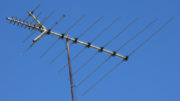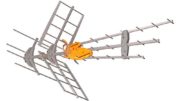This one’s easy, but it might not be the answer you were expecting. The safest antenna to use during a storm is an indoor antenna.
Outdoor antennas are all equally safe…
It doesn’t matter if you have a traditional yagi-style antenna on your roof or one of the new plastic-clad smaller antennas. Both of these antenna styles are just as likely to be struck by lightning. You might think the bare metal of the yagi-style antenna would make it more of a lightning attractor. That really isn’t true. You could make some argument that the larger surface area of a larger antenna makes it easier for lightning to strike but that really isn’t true either.
Any piece of metal on your roof that isn’t properly grounded is going to be a hazard. If there’s enough potential energy in the air that a lightning strike is about to happen, it doesn’t matter how much plastic or how much area or anything. The lightning is going to find something close enough, and with low-enough resistance, and folks… it’s going to happen.
…as long you’re properly grounded, you’re likely to be ok.
Properly grounded antennas are a lot safer. A grounded antenna will channel smaller amounts of electricity into the ground. It may stop the static buildup which can lead to a lightning strike. In the case of a lightning strike, as much energy as possible will be directed into the ground as well, but that’s not the point. The point is that proper grounding can actually prevent problems from getting to that point.
The fact, though, is that lightning is going to strike if it’s going to strike. Proper grounding is essential for minimizing the effects. If the only path for the electricity is through the cable into your home, you’re going to have really severe problem. That’s why Solid Signal offers all the parts you need to properly ground all your outdoor equipment.
Grounding rules and ordinances vary from town to town but often times it’s as simple as running a ground wire from your antenna to a cold water pipe. Sometimes you’ll need to go all the way into a grounding rod. The best option for you is to visit your local city hall and get more information about the rules in your area. Any licensed contractor should also have all the information you need.
Indoor antennas are great too
You’ll find that today’s indoor antennas are really much more powerful than they used to be, and you may find that an indoor antenna is the way to go. You can even use a small outdoor antenna but mount it inside if you don’t want to put it up on the roof. You’ll find the best selection of antennas when you shop at Solid Signal, of course. If you’re not sure which antenna you need, don’t rely on an app. Get a professional recommendation from a real antenna tech. Our service is free and it starts with this form. You’ll get a full report that lets you choose the right antenna and accessories… including grounding supplies.





